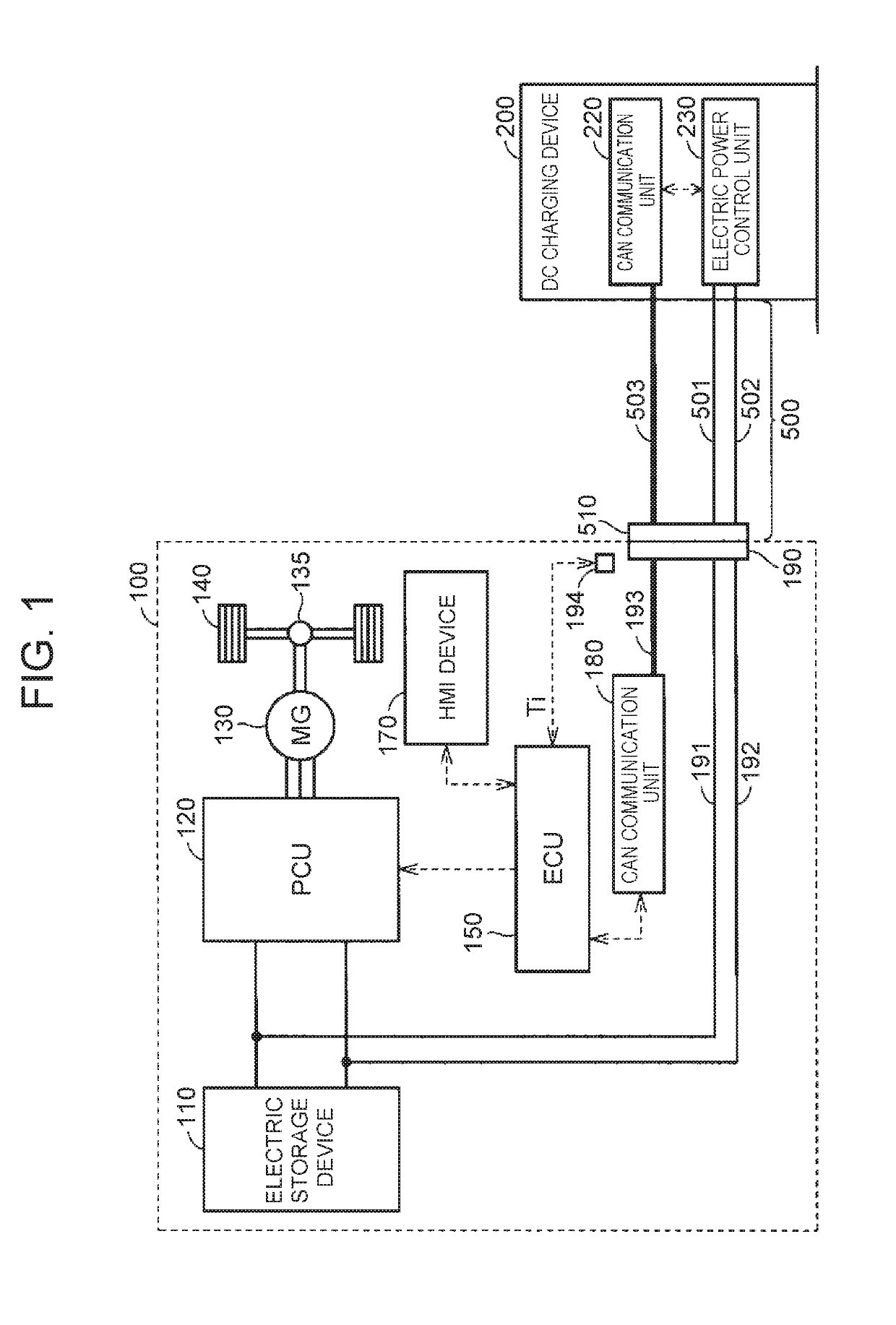Vehicle and electric power control device for vehicle
a technology for electric power control devices and vehicles, which is applied in the direction of electric devices, battery/fuel cell control arrangements, electric devices, etc., can solve the problems of excessively limited charge power, excessive dc charge, and high so as to shorten the time required for dc charge and increase the maximum output of dc charging devices , the effect of increasing the temperature of current-carrying components and shortening the time required
- Summary
- Abstract
- Description
- Claims
- Application Information
AI Technical Summary
Benefits of technology
Problems solved by technology
Method used
Image
Examples
first modification
[0089
[0090]In the example described in the above embodiment, the DC inlet temperature Ti detected by the temperature sensor 194 is monitored in the current limiting process.
[0091]However, the DC inlet temperature Ti is not necessarily limited to the detection by the sensor. For example, the DC charge time and the charge current may be adopted as parameters in the calculation of the DC inlet temperature Ti.
[0092]Further, the object to be monitored in the current limiting process is not necessarily limited to the DC inlet temperature Ti. For example, in the case where there is a current-carrying component that is weak against heat, other than the DC inlet 190, in the circuit through which the charge current flows, the temperature of the current-carrying component may be monitored instead of or in addition to the DC inlet 190.
second modification
[0093
[0094]In the example described in the above embodiment, the DC inlet temperature Ti is used as the parameter relevant to the temperature of the DC inlet 190 (current-carrying component). Specifically, in the example, in the current limiting process, the charge current is limited when the DC inlet temperature Ti exceeds the threshold Tth. Further, in the example, in the threshold setting process, the threshold Tth that is used in the current limiting process is set to a lower value, as the possible output current value Imax of the DC charging device 200 is higher.
[0095]On the other hand, in an example that will be described in the modification, an increase rate (hereinafter. also referred to as a “DC inlet temperature increase rate ΔTi”) of the DC inlet temperature Ti is used as the parameter relevant to the temperature of the DC inlet 190 (current-carrying component). Specifically, in the example, in the current limiting process, the charge current is limited when the DC inlet ...
third modification
[0113
[0114]The temperature increase characteristic of the DC inlet temperature Ti in the DC charge can change due to a deterioration, a poor contact or the like at the contact portion between the DC charge connector 510 and the DC inlet 190.
[0115]FIG. 8 is a diagram showing an exemplary change in the temperature increase characteristic of the DC inlet temperature Ti in the DC charge. A curve Ld shown in FIG. 8 is the same as the curve Ld shown in FIG. 2 and FIG. 5 described above. That is, the curve Ld is a curve showing the change in the DC inlet temperature Ti when the charge current is the predetermined value Id.
[0116]In the case where a deterioration, a poor contact or the like does not occur at the contact portion between the DC charge connector 510 and the DC inlet 190, it is assumed that the DC inlet temperature Ti increases along the curve Ld.
[0117]However, in the case where a deterioration, a poor contact or the like occurs at the contact portion between the DC charge conne...
PUM
 Login to View More
Login to View More Abstract
Description
Claims
Application Information
 Login to View More
Login to View More - R&D Engineer
- R&D Manager
- IP Professional
- Industry Leading Data Capabilities
- Powerful AI technology
- Patent DNA Extraction
Browse by: Latest US Patents, China's latest patents, Technical Efficacy Thesaurus, Application Domain, Technology Topic, Popular Technical Reports.
© 2024 PatSnap. All rights reserved.Legal|Privacy policy|Modern Slavery Act Transparency Statement|Sitemap|About US| Contact US: help@patsnap.com










